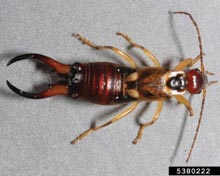
Gary Alpert, Harvard University
Earwigs
General Description
Earwigs are brown, flat-bodied insects, up to three-fourths of an inch long. On their tail ends are pincer-like
appendages used for capturing prey, defense and mating. Earwigs can bite and pinch people who handle them,
but are otherwise harmless. Their ability to bore through the ears to lay eggs inside a person’s brain is a popular
myth. Earwigs are most active at night and are attracted to lights. They rest in moist cracks and crevices by day,
coming out at night to feed on a wide variety of items including mold, fungi, algae, plants, insects, spiders, fruits,
vegetables, meats and garbage.
General Control
Earwigs abandon drought-stricken ground to enter structures in search of moisture. To avoid invasions, reduce
outdoor lighting as well as moisture and vegetation around the foundation. Foundation perimeter treatments with
residual insecticides and/or baits labeled for earwig control can help reduce Earwig populations.









